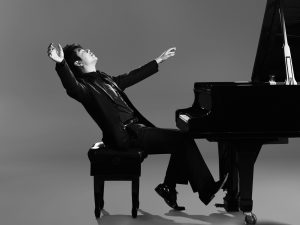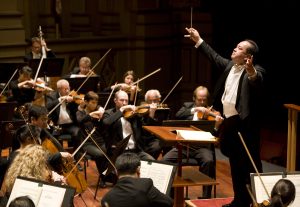Lang Lang Finds Subtlety in Beethoven

Pianist Lang Lang (Photo by Detlef Schneider)
Recently the “made in China” label has been tarnished by controversies, including outsourcing and sweatshop labor practices. But neither politics nor controversy has clouded the superstar status of Lang Lang, the ubiquitous Chinese concert pianist who opened the San Diego Symphony fall season Friday (Oct. 5) under Music Director Jahja Ling.
Lang’s presence on the program surely accounted for the sold-out house—the orchestra may have a respectable following, but sold-out symphony concerts are rare at Copley Symphony Hall—and the audience showered him with an unusually ardent and raucous response. And that was before he sat down to play the concert grand.
Unlike the showy, late Romantic barnburners he typically favors, Beethoven’s Fifth Piano Concerto (“Emperor”) was his choice for this concert. I thought his approach to this elegantly structured classcial concerto was restrained and almost understated, at least by comparison to his earlier performance profile.
What stood out was his shimmering legato line, that silken connection of notes, whether a rapid flourish or a gentle, undulating melody. In his hands, the piano ceased to be a percussion instrument, but gave the illusion of a buoyant string or woodwind timbre.
It would take a listener with a cold heart not to be wooed by his suave dynamic transitions, especially those sudden pianissimos that draw the listener to the edge of his seat to catch his subtle inflections. During the concerto’s spiritual middle movement, I thought he was deliberately playing under the violins—who were already in a delicate dynamic mode—just to make us aware of his refined ruminations.
Not everything was pastel. In the development of the opening movement, for example, he vividly brought out the athletic counterpoint in the left hand, and he pulled out all the stops for the triumphant return of the brilliant rondo theme in the finale.
While Lang’s keyboard technique may have more in common with Saint-Saens than with Mozart, his sense of proportion and architecture is throughly classical.

Music Director Jahja Ling (Photo by David Hartig)
On the podium, Ling proved a sensitive partner to the soloist, tailoring the orchestra’s phrasing and dynamics to his approach, and the orchestra’s drive and linear clarity charged the score at every turn. Ling and Lang exhibit abundant amicable collegiality, which clearly pays off in performance. In January of last year, Lang played three different concertos with Ling and the orchestra in a weekend residency, and on Friday (October 5) the orchestra announced that Lang would be the soloist when the San Diego Symphony makes its Carnegie Hall debut on October 29, 2013.
Lang’s sole encore was Chopin’s familiar “Minute” Waltz in D-flat Major.
Modest Mussorgsky’s popular “Pictures at an Exhibition” followed the opening night intermission, but Ling chose not to play Maurice Ravel’s familiar orchestration of the work the composer originally wrote as a piano solo. Ling’s choice of a compliation of various transcribers—selected by conductor Leonard Slatkin—gave a fresh take on the piece, although not one that would encourage replacement of the brilliant Ravel standard.
Russian musicians, notably the pianist-conductor Vladimir Ashkenazy, have complained that Ravel’s transcription of Mussorgsky is “too French,” i.e. elegant and colorful, and that a more faithful transcription would give a “darker,” Russian palette to the programmatic character of “Pictures.”
I heard Ashkenazy’s entire transcription in performance some years ago at the San Francisco Symphony, and I must say it was not compelling enough to make me want to give up Ravel. Perhaps the comparison would be someone who has develped a taste for elegant puff pastry being told that rice pudding is preferable because it is wholesome and what grandmother made.[php snippet=1]
The orchestra gave a spirited account of Slatkin’s “Pictures” compilation, and a few movements stood out. “Bydlo” (sometimes called “The Oxcart”) sounded as brooding and ominous as many a passage in Prokofiev’s “Alexander Nevsky,” but that movement was transcribed by the Englishman Henry Wood! Leopold Stokowski’s version of “The Catacombs” was darker and scarier than Ravel’s, especially with the eerie percussion, but the other movements came off muted and bass-heavy.
Until the final two movements, for which Slatkin reverted to the Ravel. When the brass thundered “The Great Gate of Kiev,” it was a glorious and welcome homecoming.
Beethoven’s Overture to Fidelio opened the concert, a tentative reading that suggested that rehearsal time was allocated to the major works. The orchestra’s fresh, well-designed arrangement of the National Anthem would have been sufficient warm-up for Beethoven and their Chinese guest artist.
[box] The San Diego Symphony repeats this concert with Lang Lang Sunday, October 7, at 2:00 p.m., at Copley Symphony Hall (750 “B” St., San Diego, CA 92101). The next offering on the Jacobs Masterwork Series is Garrick Ohlsson playing Tchaikovsky’s First Piano Concerto and Haydn’s Symphony No. 102 in B-flat Major, October12-14, 2012.
Tickets: $20-85. Box office: 619.235.0804.
www.sandiegosymphony.org[/box]

Ken Herman, a classically trained pianist and organist, has covered music for the San Diego Union, the Los Angeles Times’ San Diego Edition, and for sandiego.com. He has won numerous awards, including first place for Live Performance and Opera Reviews in the 2017, the 2018, and the 2019 Excellence in Journalism Awards competition held by the San Diego Press Club. A Chicago native, he came to San Diego to pursue a graduate degree and stayed.Read more…

“Ling and Lang” Good one.
I heard the Sunday mat and was very much impressed with Lang Lang, a flashy artist I usually imagine I dislike. On the other hand, I found our orchestra not quite up to the task — perhaps because I have been hearing so many other orchestras lately. In other words, I was excited and charmed by the Lang but not the Ling. I did, however, find the “Pictures” very exiting, if only because it was not the standard orchestration I grew up with — but yes, I was very happy to return to the familiar Ravel version at the end!